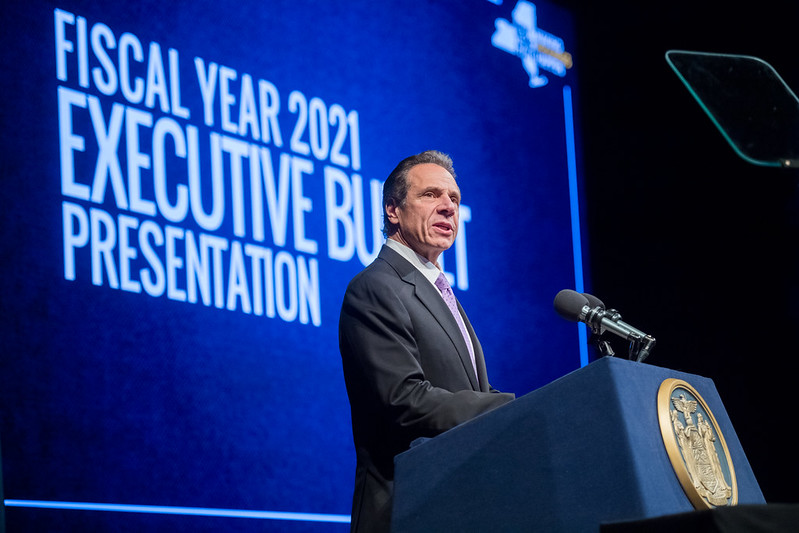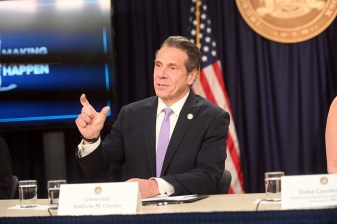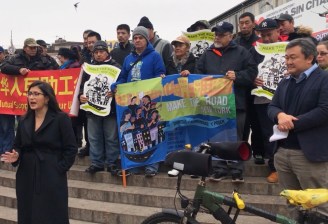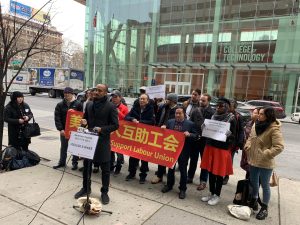Cuomo Ditches Most Helmet Requirements in E-Bike Legalization

City & State NY is hosting a full day New York in Transit summit on Jan. 30 at the Museum of Jewish Heritage. This summit will bring together experts to assess the current state of New York’s transportation systems, break down recent legislative actions, and look towards the future of all things coming and going in New York. Join Keynote Speaker Polly Trottenberg, commissioner of the NYC Department of Transportation, along with agency leaders, elected officials, and advocates. Use the code STREETSBLOG for a 25-percent discount when you RSVP here!
Gov. Cuomo has apparently seen the light on e-bikes.
After talking with advocates for delivery workers, the governor put e-bike legalization language in his executive budget that could finally legalize pedal-assist and throttle e-bikes statewide.
The Fiscal Year 2021 budget hasn’t been published online yet, but multiple sources shared the e-bike passages with Streetsblog, and Cuomo’s budget language this year mirrors the e-bike legalization bill that legislators wrote last year. It would legalize three classes of bikes with overlapping rules:
- Class 1 (pedal-assist bikes that are currently legal in New York City). These bikes have motors that cut out at 20 miles per hour.
- Class 2 e-bikes (throttle-controlled e-bikes) whose speeds also can’t top 20 miles per hour.
- Class 3 e-bikes (throttle-controlled e-bikes that can’t top 25 miles per hour and can only be operated in cities that have a population of one million or more people).
All electrified bikes can only be used on roads where the speed limit is 30 miles per hour or less, to keep e-bikes away from the fastest-moving cars. (No mention was made about keeping cars off roads with speed limits of 25 miles per hour or less.)
Cuomo vetoed last year’s legislation, citing safety “flaws,” which he later revealed involved the lack of a helmet mandate for riders of e-bikes. But under the new proposal, sources said, only riders of Class 3 bikes would have to wear helmets. Worker advocates saw this as a fair trade-off, sources said, because delivery riders who favor the fastest bikes are already required to wear helmets under city law.
“What’s important here is that there will be justice for the delivery workers who have been fighting for some dignity for a very long time,” said State Senator Jessica Ramos, the prime mover behind last year’s bill. “At the end of the day, that’s what motivated our own legislative effort, so we’re happy that it got done.”
The bill also allows cities and counties to opt out of e-bike legalization if they want to, allowing them to ban the bikes. The City Council has a pair of bills related to e-bike legalization: one that would legalize throttle e-bikes capped at 20 miles per hour and another that would fund a conversion program for delivery riders who make less than 200 percent of the federal poverty line to make their bikes street legal. Mayor de Blasio, who has waged a crackdown on riders of the illegal Class 2 and Class 3 e-bikes, has indicated he would not try to ban them once the governor legalizes them.
Two holdover from last year’s bill appear to have been eliminated from the budget bill: cyclists of any e-bike, even the currently legal pedal assist e-bikes such as those provided by Citi Bike, will be allowed to ride on the Hudson River Greenway, which is the nation’s most-popular bike lane. Last year, officials from the Hudson River Park asked for, and were granted, for e-bike operations. Unlike last year’s bill however, the budget language is said to allow passengers under the age of 16 on e-bikes, a change that advocates said will allow parents to transport their children on e-bikes.
https://twitter.com/macartney/status/1140699357022511104
Advocates were quick to praise the governor for including another e-bike push in this year’s budget, and for tying it to the push for justice for delivery riders.
“We are glad to see Gov. Cuomo take action to help deliver justice for 40,000 delivery workers by introducing a new bill to legalize their e-bikes,” Do Lee of the Biking Public Project said in a statement. “We hope the legislature will provide bipartisan support for this bill the way they did last year. Every day the bill does not pass, immigrant delivery workers suffer enormous fines and confiscations that hinder them from doing their jobs.”
Danny Harris, the executive director of Transportation Alternatives, said that the budget language “will pave the way for safe, sustainable transportation alternatives. With e-bikes and e-scooters, more New Yorkers can access opportunity while helping to address the ills associated with traffic congestion in the five boroughs and beyond.” Harris also said that when the budget language passes, advocates expect “Mayor de Blasio and the NYPD to end their misguided e-bike crackdown” and allow delivery workers to ride in peace.
E-scooters will also be legalized in the budget, in the same opt-out fashion as e-bikes. Unlike last year, scooters will be limited to 15 miles per hour instead of 20 miles per hour, and helmets will be required for scooter riders under the age of 18. The minimum age to operate an e-scooter or an e-bike will be set at 16.
Last year’s bill banned shared e-scooter programs in Manhattan, but would allow trials of “scooter share” in the boroughs. It is unclear what language will be adopted.
The budget language is an abrupt about-face from a governor who last year treated e-bikes as some kind of alien technology that was inherently unsafe. The governor’s budget bill last year classified e-bikes as “locally authorized motorcycles” When Cuomo vetoed a bill to legalize the bikes last year, he wrote that lawmakers “inexplicably omitted several of the safety measures” he’d proposed like lower speed limits and mandatory helmets.
This story has been corrected to reflect the fact that e-bikes will be allowed on the Hudson River Greenway.





